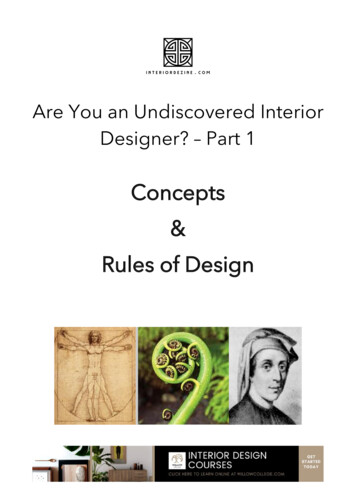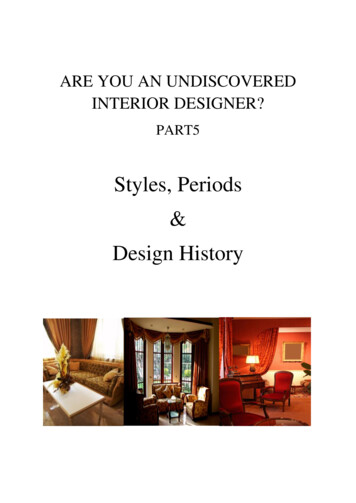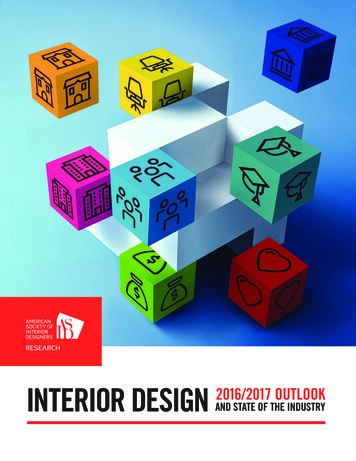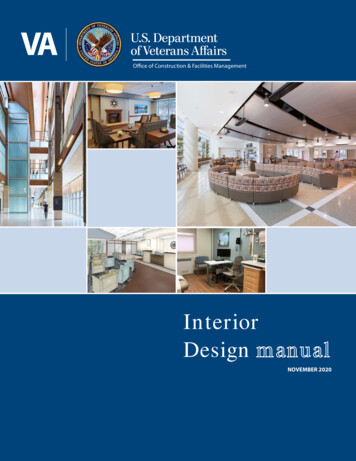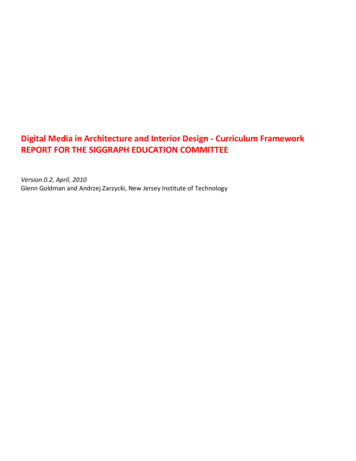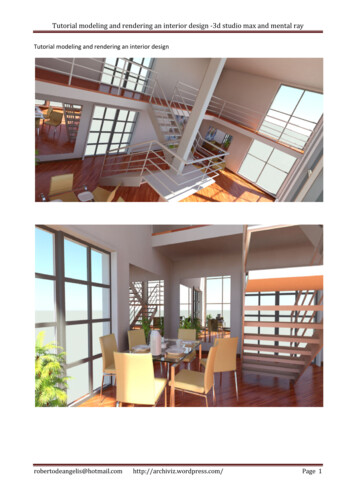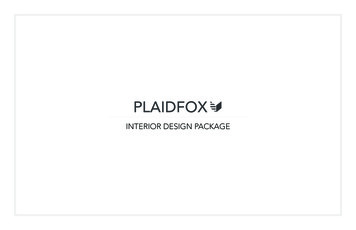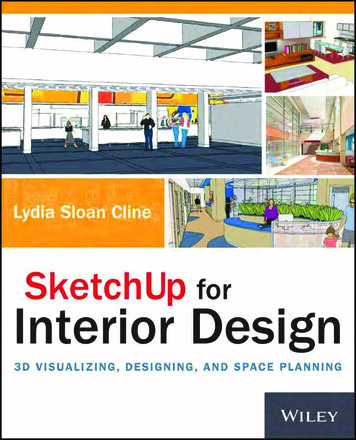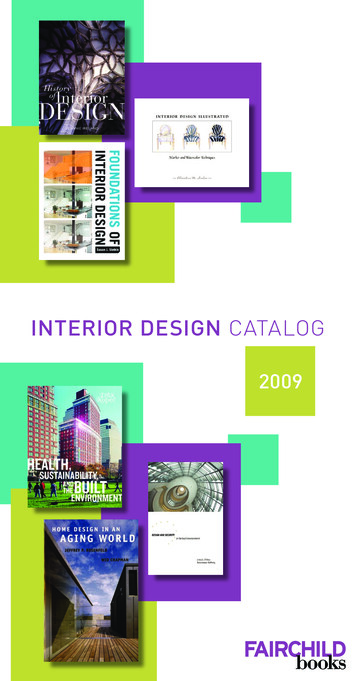
Transcription
INTERIOR DESIGN catalog2009
contentsDesign Foundations6Color12Introduction to Interior Design14Careers in Interior Design16Research Methods20Programming22Space Planning23Lighting24Materials26Textiles28History of Furniture34History of Interior Design35Drafting36Drawing & Presentation38Computer Aided Design443-D Studio Max47Professional Practices48Sustainable Design50Furniture Marketing52Furniture Design53Residential Design54Special Topics56Visual Merchandising60Reference62Author’s BiographiesIndexOrder FormsReview Copy Request FormsDesk Copy Request Form6468717577
2008 hot ListCAREERS IN INTERIOR DESIGNInterior Design: Practical Strategies for Teaching and LearningHISTORY OF INTERIOR DESIGNHistory of Interior DesignDRAWING & PRESENTATIONInterior Design Illustrated: Markers and Watercolor TechniquesPerspective Drawing: A Designer’s MethodDesign Portfolios: Moving from Traditional to DigitalCOMPUTER AIDED DESIGNModeling & Visualization with AutoCAD The Design Studio: Developing Technical and Creative SkillsUsing AutoCAD and ADT3-D STUDIO MAXAchieving Invisibility: The Art of Architectural Visualization and RenderingSUSTAINABLE DESIGNHealth, Sustainability, and the Built EnvironmentRESIDENTIAL DESIGNHome Design in an Aging WorldSPECIAL TOPICSDesign and Security in the Built Environment
new for 2009DESIGN FOUNDATIONSTaking Up Space: Exploring the Design ProcessThinking Outside the Structure: Critical Thinking for Designers & ArchitectsCAREERS IN INTERIOR DESIGNRe-de-sign: New Directions for Your Career in Interior DesignInterior Design Student’s Comprehensive ExamInterior Design: The Process, the Practice, and the ProfessionRESEARCH METHODSResearch Methods for Interior DesignInforming DesignPROGRAMMINGProgramming and Research: Skills and Techniques for Interior DesignersHISTORY OF INTERIOR DESIGNHistory of Furniture: A Global ViewDRAFTINGHand Drafting for Interior DesignHand Drawing for Designers: A Visual Guide for Drawing FundamentalsFURNITURE DESIGNFurniture Design and Construction for the Interior DesignerNEW EDITIONS FOR 2009INTRODUCTION TO INTERIOR DESIGNThe Interior Designer’s Launch Pad, 2nd EditionTEXTILESTextiles for Residential and Commercial Interiors, 3rd EditionFabric Science, 9th EditionFabric Science Swatch Kit, 9th Edition
DEsign foundationsNEW in2009! 2009est. 352 pp.softcover8.5 x 11978-1-56367-628-4 75.00 (list)Instructor’s Guide978-1-56367-629-1Taking up Space: Exploring theDesign ProcessTIIU POLDMA —University of MontrealTaking up Space: Exploring the Design Process focuses on the practice of interior design,providing an overview of what interior designers do and why, from their earliestresearch through to the completed built environment. It begins by presenting thedesign process in diagram form, and subsequent chapters break each componentdown so that one step builds upon the last. The engaging narrative introduces designmethodologies and explores the different approaches designers take to solve designproblems that meet the needs of the end-user.CONTENTS Introduction to Design Processes and ThinkingDesign MethodologiesThe Interior Design ProjectScenarios, Design Briefs, and UsersContextualizing Interior Design ProblemsCreative Genius in Design Problem SolvingExpressing and Refining Ideas: From 2D to 3D to SolutionsFrom Process to RealityDesign Sensibility, Aesthetics, Sustainability, and EthicsFrom Product to ResearchFEATURES R eal-life examples throughout the entire design process stimulatestudent learning Case studies in interior design and how interior design intersects with otherdisciplines – architecture, urban design, industrial design, and interactive design Examples of both 2D and 3D design layouts, including color, form, and materials Short exercises and in-class design projects for students to complete on their ownrelated to concepts discussed in each chapter Series of design exercises through two or three chapters to build on one or moredesign projects Instructor’s Guide provides guidelines for using the text in interior design theoryand design studio courses and practical applications with additional exercises61.800.932.4724, option 1 www.fairchildbooks.com
New in 2009!pl e a s econ ta c t you ra ccou n t m a na g e rf or de ta i l s 2010est. 272 pp.softcover6x9978-1-56367-719-9 68.00 (list)Instructor’s Guide978-1-56367-720-5Looking Beyond the Structure: CriticalThinking for Designers & ArchitectsDEsign foundationsNEW in2009!DAN BUCSESCU —Pratt InstituteMICHAEL ENG — Pratt InstituteThis text examines the relationship between the built form and culture and serves asan introduction to thinking philosophically about design theory for students in interior design and architecture. Through a series of primary and secondary reading selections written by important architects, critics, and thinkers, students are introducedto paradigms and models for interpreting the built environment and encouragedto think on their own about their designs for the built environment. Readings andsubsequent “Dialogues,” or exchange of ideas and stories, encourage design considerations and facilitate holistic thinking in the design process.CONTENTS What is Design? What is Architecture?What is Function? What is Form?What is Natural? What is the Artificial?What are Appearance and Reality?What is an Event?What is Geometry?What is Context?What is Communication?How Buildings Mean?What is Imagination?What is Beauty?What is Intention?What is Place?What is Design? What is Architecture?Translation from Text to Image and Other Examples of Useful Sketch ProblemsFEATURES Focuses on skills such as critical thinking and problem solving Selected readings appropriate for all levels - from foundation to advanced courses Weekly assignments consisting of short written responses to the readings“Dialogues” Final assignment to write a “Personal Manifesto” Appendix includes glossary of key terms and extensive bibliography Instructor’s Guide includes suggestions for additional practice-based andresearch-based assignments1.800.932.4724, option 1 www.fairchildbooks.com7
DEsign foundations 2006272 pp.illustratedsoftcover8.5 x 111-56367-412-2 74.50 (list)Instructor’s Guide1-56367-413-0PowerPoint Presentation1-56367-414-9The Design ProcessKARL ASPELUND —University of Rhode IslandThe Design Process explores the route of a design through seven stages from the Worldof Imagination to the World of Objects, starting the journey at inspiration with production as the destination. Aspelund emphasizes the need to understand one’s owncreativity in order to develop and communicate ideas. He examines the designer’sroles—artist, dreamer, performer, manager, coordinator, communicator, and problemsolver. Supplementing the author’s insights from his personal experience are theperspectives of other designers.CONTENTSIntroduction Stage 2: Inspiration Stage 3: Identification Stage 4: Conceptualization Stage 5: Exploration/Refinement Stage 6: Definition/Modeling Stage 7: Communication Stage 8: ProductionAppendices Elements and Principles of Design Recommended Reading and Resources Notable Designers and Architects Reading the Zeitgeist: Trendspotting in a Decentralized World Zeitgeist and Design: Timeline.FEATURES E ngaging illustrations to present concepts discussed in the text in memorablevisual terms Perspectives of seven professional designers, who work in a variety of media butfollow similar paths as they confront the issues posed by each stage of thedesign process End-of-chapter exercises to help students move their own projects through theseven stages Instructor’s Guide includes suggestions for ways to examine topics and applypractices discussed in each chapter as well as ways to evaluate students’ designprojects and responses to the exercises in the text PowerPoint Presentation highlights the text coverage, providing a frameworkfor lectures and discussion in a studio or classroom; compatible with PC andMac platforms81.800.932.4724, option 1 www.fairchildbooks.com
Instructor’s Guide978-1-56367-334-4Instructor’s CD-ROM978-1-56367-454-9Wear Your Chair: When Fashion MeetsInterior DesignDEsign foundations 2007240 pp.llustratedfull colorhardcover8.5 x 11978-1-56367-581-2 60.00 (list)JUDITH GRIFFIN —California State University—NorthridgePENNY COLLINS —Woodbury CollegeDesign has become our means of personal expression, whether we’re buying MarthaStewart sheets at K-Mart, lining up for the latest Air Jordan sneakers or ManoloBlahnik pumps, or driving a Mini Cooper to our Frank Lloyd Wright-inspired house.Wear Your Chair is dedicated to the proposition that all design disciplines are createdequal—and all of them should be fun. They also overlap. The authors examine designhistory, trends, and ideas about creativity with the goal of expanding our understanding about how these overlaps work. We learn how influential designers work acrossmany mediums and possess a design “tool kit”: a respect for the past, an understanding of technology, the pursuit of creative and collaborative solutions, and a willingness to keep learning. We see how design, function, and form—from light fixtures topackaging to shoes—is grounded in innovation with respect for the past. Aimed atfashion and design students as well as aficionados, this is a book about looking at theworld without strict definitions—and about thinking outside of the box.CONTENTS ear Your What?W W here It All Starts: References and Influences Sources of Design Inspiration The Vocabulary of Design More Than Meets the Eye: Surface Design, Pattern, and Motifs Furniture and Fashion: How to Wear Your Chair Inspiration from Textiles: Everything Old Is New Again Trend Forecasting: Seeing What’s Not There . . . Yet Design and the Shopping Experience W hen Life Became StyleFEATURES I llustrations emphasizing the unification of design and fashion—from clothingand textiles to magazine ads, perfume bottles, furniture, and architecture Boxed features with articles and interviews with designers about their work Exercises and end-of-chapter projects; and hundreds of additional sources I nstructor’s Guide provides general suggestions for teaching the course, including possible schedules for semester and quarter courses and advice about teamteaching; discussion questions and activities are offered for each chapter I nstructor’s CD-ROM contains articles for each chapter from professional andgeneral interest publications to supplement the readings in the text1.800.932.4724, option 1 www.fairchildbooks.com9
DEsign foundations 2005288 pp.illustratedfull colorsoftcover6x91-56367-349-540.00 (list)By Design: Why There Are No Locks onthe Bathroom Doors in the Hotel Louis XIVand Other Object Lessons2nd EditionRALPH CAPLANForeword by Paola Antonelli —Curator, Department of Architecture and DesignMuseum of Modern ArtAn inspiring resource for design students, professionals, or anyone else who couldbenefit from a fuller appreciation of the design process, By Design vividly shows howdesign affects our most significant human activities. A network of engrossing storiesilluminate the process as it applies to architecture, industrial design, interior design,fashion design, graphic design, and the design of business and social situations. It isthe perfect accompaniment to a broad area of foundation courses for designers-intraining. This new edition of the popular classic features updated examples of timeless ideas, illustrated in full color. A concluding chapter discusses what has, and hasnot, changed since the first edition, examining design responses to radical technological development and shifting consumer demands.CONTENTS Th e Possibilities of Design . . . the misplaced art of making things right The Professional Emergence . . . where industrial designers came, andare coming, from The Way Things Mean . . . what goes on between us and our artifacts The Prop . . . what chairs are for A Pride of Camels . . . we are all designers Suitable for Framing . . . is design art? The Design of Possibilities . . . the shift from object to situation Making Connections: The Designer as Universal Joint . . . object lessons in thework of Charles and Ray Eames The More Things Change, The More We Stay the Same . . . design and societyrespond to change and to each otherFEATURES N ew chapter explores the design response to technological changes, discussesheightened public awareness, and the opportunities it offers Discusses and explains the theories of green design and universal design Examines the work of Charles and Ray Eames to show how their practiceencompassed product design, interiors, exhibitions, architecture, and filmmaking101.800.932.4724, option 1 www.fairchildbooks.com
Cracking the Whip:Essays on Design and Its Side EffectsDEsign foundations 2006320 pp.illustratedsoftcover6x91-56367-390-8 15.00 (list)RALPH CAPLANForeword by Milton GlaserDesign is inescapably part of our lives—from the alarm clocks we wake up to and thecups we use for our morning coffee, to the chairs we sit in, the cars we drive, and thehouses and cities we live in. In 63 engaged and engaging essays, Caplan explores howwe use design, language, and instinct in our everyday world to relate to others, maintain traditions, and advance our causes. He probes our relation to the things thatboth comfort and disorient us—from pasta to corporate culture—and shows how weare shaped by our own artifacts and our attitudes toward them. Our sense of placeand regional diversity are also examined—as are the shock of the new, the persistence of the old, and the expectation of a future. In this age of global sensibilities and“tourism as a lifestyle,” we’re continually recycling as we create. Previously publishedin forums such as The New York Times, I.D., Print, and Interior Design, Caplan (author ofthe popular classic By Design) is sharp, thoughtful, c
Design Foundations 6 Color 12 Introduction to Interior Design 14 Careers in Interior Design 16 Research Methods 20 Programming 22 Space Planning 23 Lighting 24 Materials 26 Textiles 28 History of Furniture 34 History of Interior Design 35 Drafting 36 Drawing & Presentation 38 Computer Aided Design 44 3-D Studio Max 47 Professional Practices 48 Sustainable Design 50 Furniture Marketing 52
